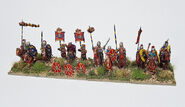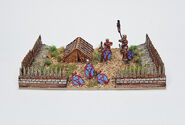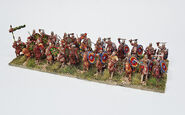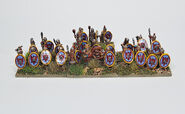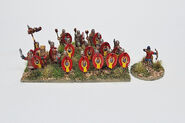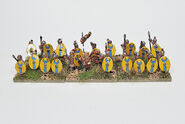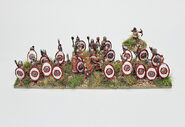Background[]
The Imperial Roman list covers the period from the death of Gallienus to when Stilicho was forced to return the eastern troops to Constantinople's authority following the death of Theodosius the Great (actually, this occurred in 395 CE so it is a bit of a mystery why the list runs to 396 CE). Thus the list covers the later part of "The Third Century Crisis", the formation and collapse of "The Tetrarchy", the rule of the houses of Constantine and Valentinian, and finally the reign of Theodosius the Great. It includes numerous civil wars, the ill-conceived and disastrous invasion of Persia by Julian, and the disaster of the Battle of Adrianople where the emperor Valens was killed. The period did, however, also include many Roman successes against foreign enemies, and in general the Roman army won far more battles against these than it lost.
The army had evolved somewhat from that of the early empire. Whilst the core and main strength of the army remained its infantry, these had themselves changed and the supporting cavalry had become more varied. Additionally the structure of the army had changed, and continued to change of the course of the period covered by this list. The legions had ceased to operate as entire entities of 5000+ men and instead were deployed as smaller "vexillations" of about 2000 men in multiple locations. Around the turn of the 4th century this started to become formalised with the separate vexillations turning into distinct units on their own, although in reality this was what they had become anyway. This change is usually attributed to either Diocletian or Constantine, or some combination of the two.
Constantine further changed the army when he came to power dividing it into two broad parts. Firstly there was the "Comitatus", the troops who were under the direct command of the emperor as his field army; these were then seen as the elite troops and were know as "Comitatenses". Secondly there were forces stationed on the borders of the empire under commanders with smaller geographical authority; inevitably these were then seen as 2nd class compared to the comitatus and were know as "Limitanei" or "Ripenses".
Following Constantine, and maybe during his reign, the comitatenses troops were divided between his sons and developed into "regional" field armies accross the empire. The structure of the army continued to change right up until the end of the period of this list. The eastern army came to have 5 of these regional armies as is detailed in the Notitia Dignitatum; however, the position in the west is much less clear as the portions of this document that pertain to the west are dated later and show evidence of much amendment.
From the reign of Valentinian I some of the comitatenses troops started to be know as "Palatina" and had higher seniority. The title is associated, as you can guess, with being close to the emperor and it is likely that it was troops directly commanded by the emperor who first got this attribution, although it later spread wider.
Despite the view of many wargamers (and others) the Roman army of this period still relied on the heavy infantry who were the most numerous and effective part of the army. Whilst it is true that there was more cavalry, and more variety of cavalry, these were still mainly used in support of the infantry and not expected to be the battle winners. Indeed, in the 4th century there are a number of examples where the cavalry performed quite poorly and it is clear that the infantry won the battles.
Using Imperial Roman in MeG[]
How to use a particular army effectively can be a very personal thing, and where a list - and the Imperial Roman is one - contains a large variety of troops there will not usually be a single answer. The style of army that suits one players may not suit another. So with that caveat this is one take on using an Imperial Roman army.
Its the infantry, stupid! If I may be a touch tongue in cheek being successful with this army is all about the infantry, they will win you or lose you the game. All the other troops are there to support the infantry. Some such as the Clibanarii can pack an effective punch on their own, but their numbers are limited.
The cutting edge of the army will be Superior Legionaries and Auxilia, maybe even with a unit of Exceptional guards to really frighten the enemy - there is very little Exceptional Legionaries fear. Due to their points cost (quality don't come cheap) and the list limitation on how many units can be Superior and/or Exceptional it is likely that you will have between 3 and 5 of these units. Your battle plan needs to be based around getting the maximum use from these, so getting them into the enemy is key. To a great degree the other troops in the army are mainly there to ensure the key troops get in and hit hard, but even Average Legionaries and Auxilia are very capable troops.
I would always give the Legionaries and Auxilia the Melee Expert characteristic, and I am not a fan of using the option to regrade the infantry with Darts in this list. One exception to the use of Melee Expert can be the Exceptional guard Legionaries - if you do need to save some points these are still extremely useful without it; they are better than Superior in the Charge Phase, the same in Melee Phase and Skilled shooters do not get the colour upgrade if shooting at them.
If facing an army with a lot of shooting remember that you can "Prompt through fire" to remove the 1BW move reduction for using Shield Cover and this allows you to keep pressing forward and pressurising the enemy. Your Professional generals should help you to have the necessary cards/discs where you need them and Block Moves can be very efficient for this as well.
With all the main infantry in the army being Flexible to some degree the terrain you fight over is not a big issue for this army - and the Lagionaries and Auxilia are possibly the best terrain troops there are out there in fact. However, it is not the largest army out there and it can be useful to try and cut down the area of the table you will be fighting on if at all possible. You may also find that in some games using the compulsory Fortified Camp as na anchor for one wing can be effective.
Allies[]
Armenian allies (in Syria or Asia from 296 to 298 CE) - from the Syria and Asia Minor PDF. The reason to take this ally would be to add some Protected Charging Lancer cavalry and skirmisher horse archers to the army.
Nomadic Arab allies - Later Pre-Islamic Bedouin (in Syria or Asia from 305 CE) - from the Byzantium PDF. The reason to take this ally would be to add Flexible Unprotected Long Spear cavalry and Protected Long Spear cavalry to the army.
Tervingi allies (Western army in Illyricum in 324 CE) - from The Balkans and Pontic Steppe PDF. The reason to take this ally would be to add a mass of cheap Flexible infantry to the army.
Armenian allies (in Syria from 325 to 363 CE) - from the Syria and Asia Minor PDF. The reason to take this ally would be to add some Protected Charging Lancer cavalry and skirmisher horse archers to the army.
Imperial Roman as allies[]
The Imperial Roman list is not available as an ally in any other lists.
Troops and suitable miniatures[]
"Core" Troops[]
Legionaries and Auxilia[]
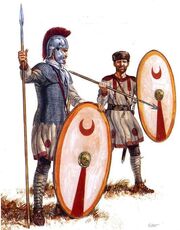
By the time of this list the old distinction between Legionaries and Auxilia had to a great degree disappeared, although units were still designated as one or the other. Equipment had become standardised with the men equipped with mail (or possibly scale) body armour, a steel helmet, a large oval shield, sword and spears of various types - some of the latter being the equivalent of the earlier pila. From the reign of Diocletian darts (martiobarbuli/plumbata) started to be used in addition becoming more common over time.
It used to be thought that the Auxilia did not wear body armour, however, this is no longer the accepted position, although no doubt on occasion the armour was left off for certain operations. Most older sources for wargamers will show the Auxilia as unarmoured. Of course, less well equipped units of any sort may have been lacking as well, and this may have been the case for many units raised after the Adrianople disaster until they could be properly equipped.
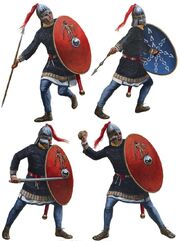
Most figure manufacturers carry both armoured and unarmoured figures and so you can choose which you want depending on your view of what is suitrable or just how you want your army to look. In many ways the large shield with distinctive unit designs is the most important thing as that is what will catch the eye of any onlooker (and your opponenmt who will be looking directly at them).
The army list allows various interpretations of how the Roman infantry of this period fought, and indeed allows you to mix the different interpretations on the basis that it is quite possible that there was a lack of uniformity across the empire.
Additionally the evidence suggest that units contained a proportion of archers who would shoot in support of the hand to hand troops and these are represented by the Integral Shooters characteristic. This can also cover the increasing use of Darts.
Equites and Equites Illyricani[]

These are the standard Roman cavalry equipped much in the same was as the Legionaries and Auxilia with body armour, helmets, large oval shields , swords and spears. They also carried a small number of javelins. It has been suggested that those classified as "Illyricani" were more adept/focused on skirmishing (although the reaons for this are not clear) hence the distinction in the army list. The "Dalmatae" are similar but may have carried a smaller shield.
As with the Auxilia mentioned above it has been suggested that the Illyricani did not wear body armour, but again this is not the commonly accepted position. However, using figures depicted as such will not be an issue so if you choose to depict thme this way, or are using older figures, don't worry.
Catafractarii/Clibanarii[]
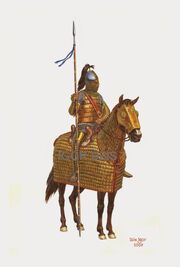
There has been much debate over the years as to how these troops were equipped and whether there was any difference between the Catafractarii and the Clibanarii. In the period prior to this list the Catafractarii appear to have been Equites equipped with the long contos in the manner of the Sarmatians, and as such are Protected Charging Lancers. For the period covered by this list the most common view is that these were now fully armoured men on armoured horses in the style of the Parthains and Sasanid Persians, and that the Clibanarii were the same, just with a different unit name. They were armed with the long contos and would not have carried shields.
As such they would probably have looked very similar to the Parthians/Persians but with certain parts of their equipment looking more Roman. This gives you a pretty free rein to choose your figures and any marketed as Roman, Sasanid or Parthian (or Palmyran) would be good to use - pick the ones that you like best or fit the image in your head.
Equites Sagittarii (horse archers)[]
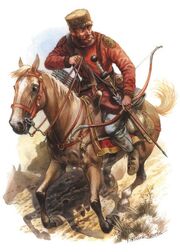
To support the heavier cavalry, and combat enemy horse archers especially in the east, the Romans had numerous units of their own horse archers. It is assumed that these would be similar to other horse archers such as the Parthains in being unarmoured except maybe for a helmet, however the direct evidence for this is lacking. That said the army list classifies then as Unprotected i.e. with no armour.
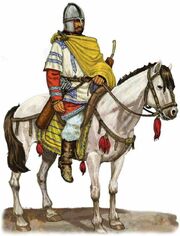
Where are the Gothic Foederates?[]
Players coming to MeG from other rule sets, or with only basic historical knowledge of the period may well be asking why there are no Gothic Foederates in the list following the settlement of the Goths in the empire in 382 CE. Many, if not all older sources and wargames lists have Gothic tribal troops available from this date.
The answer to that is that more recent reseach has cast severe doubt over the nature of the Gothic settlement and their responsibilities thereafter. This is especially true of their involvement in the Roman army. Strong arguments have been made that whilst a very significant number of Goths were enrolled in the army that they were recruited into regular units under Roman officers and not as some sort of tribal force recruited on an as needed basis. The MeG list reflects this view. Smaller numbers are, however, allowed to represent contingents recruited from beyond the frontiers by the eastern empire.
Miniatures[]
The following suppliers have 15mm figure ranges that are suitable for making an Imperial Roman army. All of them have figures for all the "core" troops such as Equites, Catafractarii/Clibanarii, Legionaries and Auxilia including the various interpretations of what they actually were. Other ranges are available and a Google serach should find them easily or ask on the MeG Forum or Facebook group.
Whilst the Lurkio/PSC infantry are excellent, I would not recommend the Lurkio/PSC cavalry but would use another manufacturers figures instead - Khurasan Miniatures and Forged in Battle will sit well beside the Lurkio/PSC infantry. Legio Heroica don't mix so well with the other ranges noted below, however, cover all the troops needed.
Lurkio - https://thelittlecorporal.co.uk/late-roman-206-c.asp
The Plastic Soldier Company - https://www.theplasticsoldiercompany.co.uk/mortem-et-gloriam/ - these are Ultracast "plastic" versions of the Lurkio figures.
Khurasan Miniatures - https://khurasanminiatures.tripod.com/lateroman.html
Essex Miniatures - https://www.essexminiatures.co.uk/collections/15mm-ancient-roman?page=3
Legio Heroica - http://www.legio-heroica.com/Copia%20di%20Tardo%20Romani-en.html
Forged in Battle - https://www.forgedinbattle.com/index.php?route=product/category&path=195_200
In addition Little Big Men Studios supply an excellent range of shield transfers based on the patterns in the Notitia Dignitatum for the Khurasan Miniatures range (these also fit the Lurkio and Plastic Soldier Company ranges) and the Legio Heroica range. LBMS supplied transfers are also available from Forged in Battle for their Late Roman range.
Painted Figures[]
A few pictures of painted 15mm Imperial Romans. Infantry are Lurkio and the cavalry are Khurasan Miniatures all using shield transfers from Little Big Men Studios. The camp is from Baueda though Magister Militum.
References[]
As there are innumerable books on the period covered by this list I'll just go with a small selection of easily available ones that can get the newer player started with this army.
There are 2 useful Osprey titles that can get you going with the Imperial Romans:
Late Roman Infantryman - https://www.amazon.co.uk/Late-Roman-Infantryman-236-565-Warrior/dp/1855324199/
Late Roman Cavalryman - https://www.amazon.co.uk/Late-Roman-Cavalryman-236-565-Warrior/dp/1855325675/
They also publish 3 titles on specific battles in the period covered by this list:
The Battle of the Milvian Bridge where Constantine defeated Maxentius in a civil war - https://www.amazon.co.uk/Milvian-Bridge-AD-312-Constantines/dp/1472813812/
The Battle of Agentoratum (Strasbourg) where the Caesar Julian defeated the Alamanni - https://www.amazon.co.uk/Strasbourg-AD-357-victory-Campaign/dp/1472833988/
The Battle of Adrianople in 378 CE where the Goths defeated, and killed the emperor Valens - https://www.amazon.co.uk/Adrianople-AD-378-legions-Campaign/dp/1841761478/
Example Army Lists[]
List PDF Link[]
https://lurkio.co.uk/meg/meg/wp-content/uploads/MEG2022/MeG-Army-Lists-25-Italy-2022-01.pdf
Example Lists[]
10,000 point Maximus list from Nik Gaukroger
10,000 point Maximus list with Arab allies from Nik Gaukroger

